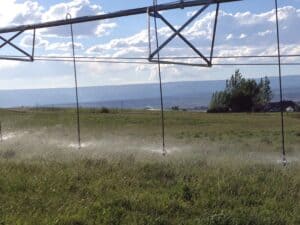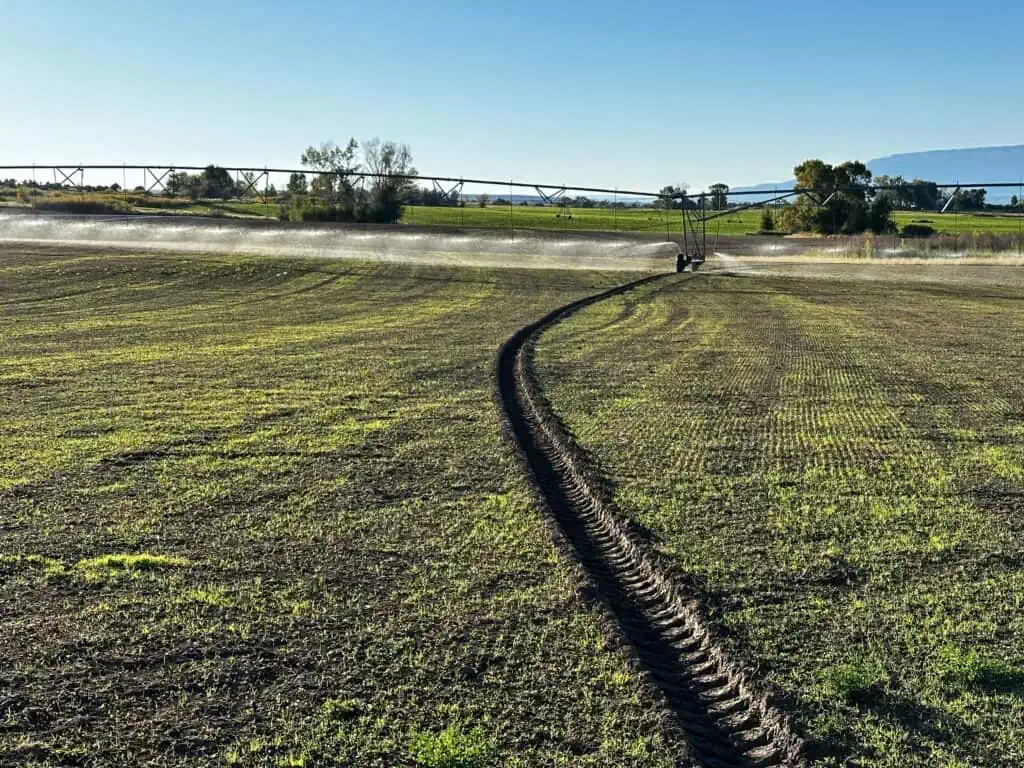NRCS Projects—How to Add Value to a Ranch
By Gary Hubbell, ALC
United Country Colorado Brokers & Auctioneers
with offices in Hotchkiss, Colorado, and Carbondale, Colorado
The Natural Resources Conservation Service (NRCS) is Tasked with Conservation
If you have just entered into the world of Western ranches, you might hear the term “NRCS project” frequently discussed. Don’t you hate it when people use all these acronyms and you don’t know what it means? Sorry, I’ll explain. The Natural Resources Conservation Service is a federal agency under the auspices of the Department of Agriculture tasked with helping farmers and ranchers with conservation projects on private land, often involving water and irrigation. Back in 1933, they were founded as the Soil Conservation Service in the terrible years of the Dust Bowl, when clouds of topsoil were stripped away from farms and blown away. Today the agency has 11,000 employees with a mandate to spend money helping farmers and ranchers improve their properties—sounds like a pretty good deal.
Early settlers used primitive engineering to irrigate farms and ranches
As ranch brokers, we can typically drive up on a farm or ranch and immediately discern whether or not there has been some involvement with an NRCS project. Even primitive cultures such as the Anasazi knew how to dig an irrigation ditch using a deer shoulder bone lashed onto a stick. And God bless ‘em, the old-timers that first built our irrigation ditches were tough old coots, using mule teams, spud bars, and dynamite to bring water to dry fields. I remember one old-timer telling me how they engineered a ditch: “We had a long piece of lodgepole pine and took a quart Mason jar and filled it half full of water. We wired the jar onto the log and that’s how we found level. We pointed the stick downhill and that’s where we dug.” However primitive, it worked. But anyone who has gone to the local farm supply store to buy another roll of irrigation tarp material knows that there is a rough, tough summer ahead that involves a laborious scenario of moving water the hard way. Just as the Anasazi might have used a deerskin and some rocks to block the water in a ditch and make it flow to their corn patch, many ranchers still use an orange poly tarp, an old 2×4 for a brace, and the same old rocks to send water onto a hayfield. It’s inefficient, difficult, laborious, and sometimes very frustrating. It can be very wasteful as well, because water will pool in low spots and quickly run off of high spots, resulting in spotty and uneven cultivation.
Water is Gold in the Mountain West, and We Can’t Afford to Waste It
In Colorado, every drop of water in a stream or ditch is spoken for—see our article on Colorado Water Rights (link). Water is precious and must be used wisely. Wasted water and inefficient irrigation practices result in erosion, poor soil conditions, unwanted weeds and grass species, and substandard hay and crop production. My 118-acre ranch in Crawford, Colorado, is an excellent example. We bought the ranch in 2002 while we were running a busy outfitting business in Marble, Colorado, to use as winter horse pasture for our string of 45 mountain horses. It’s a gorgeous property, with beautiful views of the West Elk mountains, a sunny year-round climate, gently rolling hills, and excellent water rights. But it was a real challenge to irrigate. After we made the purchase, I was out there in the field the next spring slaving away, trying to chisel a track in the dirt with an irrigation shovel and get some water to a dry patch. Meanwhile, a flood of water was sluicing down through a low spot. My neighbor, the previous owner of the property, stopped by. “That’s why I sold this place,” he said. “With all its little hills and valleys, it’s really hard to irrigate. I had over 1,000 acres to irrigate and it took more time to move water on this one little place than all the rest of it combined.” Well, thanks for telling me, I thought. But it turns out that I had the last laugh. I put an NRCS project with two center pivots and several big gun sprinklers on the place, and it’s now one of the most productive hayfields in the whole valley. And guess who tried to buy it back from me?
Salinity—An Interesting Reason to Improve Irrigation Systems
We can all agree that the federal government does a lot of things that are not Constitutional. It’s hard to justify the existence of the Department of Education and Department of Energy, for example. It can be argued that all they do is mess things up. But there is a definite Constitutional duty to execute treaties with other countries, and that’s one reason why the NRCS is very involved with irrigation projects. You see, when irrigation water is sluiced through earthen ditches and poured onto fields, it saturates the ground and often penetrates deep into the soil. Many of our Western geological strata are laced with layers of salt. When that water pops back up some distance downhill, it is laden with salt, which eventually makes its way into Western rivers. The same water may be used eight or ten times to irrigate farms by the time it reaches the sea, and the water in the Colorado River at the Mexican border was so salty that it was unusable, which caused Mexico to sue the US. The US signed a treaty with Mexico to clean up the salinity in the Colorado River. My ranch is on the Clipper Ditch near Crawford. This ditch serves about 3,200 acres of land with up to 65 cubic feet per second of water. The calculations are that piping the major laterals and feeder ditches of the Clipper Ditch will result in the reduction of 20,000 TONS of salt flowing into the Gunnison River annually, and that’s a major reason why the NRCS spends money on irrigation projects.
What is the Timeframe and Application Process for an NRCS Irrigation Project?
Actually, there are many kinds of projects that are administered by the NRCS, including wildlife habitat projects, irrigation projects, invasive species elimination, soil conservation, and much more. For our purposes we will talk about irrigation projects. The process starts with the landowner filling out an application, which is then evaluated for meeting project requirements. If it is deemed to meet specs, it goes forward to a funding round. The project managers have a certain budget to work with, and they are trying to get the best bang for the buck. Your project will be competing with several others for funding. Once it passes the funding round, then it goes to the NRCS design engineers. Once the design is finalized and funding is approved, contractors are given bids to break ground. Rarely is a project approved in less than a year. Quite often it can take 2-3 years for final approval and funding.
What Kind of Cost Sharing Can I Expect from an NRCS Project?
Let’s use my ranch as an example. We installed a state-of-the-art irrigation system on about 112 total acres, using a combination of gated pipe, a 660-foot full circle center pivot sprinkler, an 1,120-foot “windshield wiper” center pivot, and 8 risers for big gun sprinklers. It has a 25-hp variable-frequency pump, 3-phase power, a “settling basin” pond, and a 480-amp power service. The total cost in 2014 dollars was about $300,000, and the NRCS paid about $200,000 of that amount, or about 2/3. Every year is different and the programs are constantly changing, but it’s fair to say that a landowner can expect anywhere from 50-100% funding, depending on the project. It is incumbent on the landowner to maintain the project for the next 20 years.
The Benefits of an Engineered Irrigation System on a Ranch Property
I already explained how challenging it is to irrigate a property using tarps and ditches, and my hay production was weak—in many cases, less than a ton per acre. Now I can make it rain on practically every inch of my fields, making for a very even, predictable saturation. I have gone the extra mile and invested in plowing, disking, and re-seeding, and combined that with a “fertigation” system whereby we inject liquid fertilizer straight into the center pivot. This past year our hay production boomed to almost six tons to the acre. It has made a huge difference in the efficacy of our little hay farm. We use our irrigation water much more efficiently, and all in all, our farm is finally profitable when it wasn’t before.
A well-designed, well-irrigated property versus one that isn’t—which would you prefer?
When even novice ranch buyers drive onto a ranch that has a well-designed functional irrigation system, they can immediately feel the difference. It bespeaks productivity, care, pride of ownership, and even wealth. They see the green hay stacked in the barn and they know it’s productive. Informed buyers are grateful when a good project has already been done. Yes, the government funds a good share of it, but it still adds significant value to the property, value that goes to the landowner. Financially it’s pretty much a no-brainer because it adds to much value and efficiency to the property. Occasionally we meet landowners who install irrigation improvements without NRCS help, and they have their reasons for doing so. But when a property is obviously deficient and needs a thorough makeover, one of the first things a new landowner should do is check in with the local NRCS office to see what funds might be available.
Gary Hubbell, ALC, is an Accredited Land Consultant, ranch real estate broker, and auctioneer. He is the managing broker and founder of United Country Colorado Brokers & Auctioneers, with offices in Carbondale and Hotchkiss, Colorado. Gary and his wife, Doris, own a 118-acre hay farm in Crawford, Colorado, where they raise high-quality horse hay and raise and train horses and Labrador retrievers. A former wilderness outfitter and hunting guide, Gary is an expert on Colorado hunting properties, outfitting businesses, ranches, resorts, income properties, farms, wineries, and vineyards.



